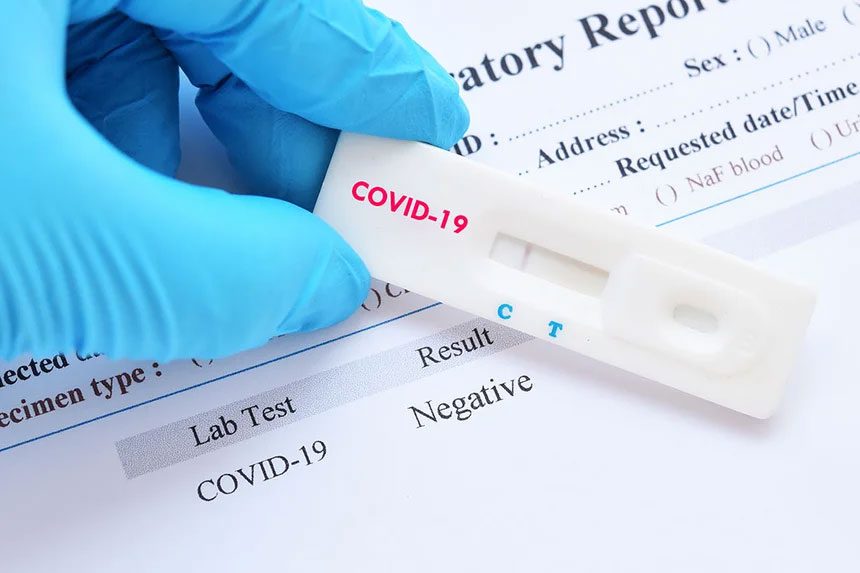Improper testing methods and low viral loads may be the reasons why Covid-19 tests yield negative results even when patients exhibit symptoms.
Every day, millions of people around the world test positive for SARS-CoV-2. Notably, the Omicron variant is currently “dominating” in many countries due to its rapid transmission rate. However, many individuals who show symptoms and have been in close contact with Covid-19 patients have received negative results on both rapid tests and rRT-PCR tests.
This situation is quite complex and can pose risks to others, as it is difficult to determine whether these individuals have avoided the virus or if the test results are inaccurate. Scientists have identified several reasons that may contribute to this issue.
Causes
The primary reason for negative results in suspected Covid-19 cases is improper testing methods. rRT-PCR testing is considered the gold standard for detecting the presence of SARS-CoV-2 in the body, but it can yield inaccurate information due to several factors.
Even when CT scans or blood tests confirm the presence of the virus, rRT-PCR tests may not verify the same.

Improper sampling and sample preservation can also affect Covid-19 test results. (Photo: Gavi).
According to India Express, this depends on whether the patient has been sampled correctly. “rRT-PCR has a sensitivity of only 60%. The results depend entirely on whether the swab was taken correctly and whether the area swabbed corresponds to the location of the virus,” stated Dr. Praveen Gupta, Director and Head of Neurology at Fortis Memorial Research Institute, Gurugram.
Additionally, improper preservation of samples during transport can also impact test results. According to Dr. Vijay Dutta from the Internal Medicine Department at ESIC Hospital (India), if the procedure is followed correctly, with accurate sampling and transport of samples at 2-5 degrees Celsius, the rRT-PCR will yield positive results if the patient is infected with SARS-CoV-2.
As reported by Forbes, Dr. Gerald W. Fischer, an international expert in infectious disease care and research, explained that if the virus is in the early replication phase, false-negative antigen tests may occur.
Research published by the U.S. Centers for Disease Control and Prevention (CDC) indicates that antigen tests provide a 20% false-negative rate in symptomatic individuals and a 59% false-negative rate in asymptomatic individuals.
Moreover, low viral loads are another factor that can result in negative test outcomes, even when an individual exhibits all the symptoms of SARS-CoV-2 infection. In such cases, doctors will rely on comprehensive analysis from other laboratory tests and X-ray results.
Dr. Rajeev Jayadevan, a clinical researcher advising the Covid-19 task force in Kerala (India), stated that for Omicron cases, the maximum viral load appears three days after symptoms emerge, peaking until the sixth day. After that, the viral load decreases. “Therefore, on the first day of symptoms, the test may yield a negative result,” Dr. Jayadevan shared.
Meanwhile, Dr. Janice Johnston, a family physician in Glendale, Arizona (USA), noted that many other common illnesses such as the flu and colds exhibit similar symptoms to Covid-19, including body aches, fever, chills, headaches, and nasal congestion.
“I believe you should test for the flu if you have symptoms suspicious of Covid-19 but receive a negative result,” Dr. Johnston advised.
In agreement, Dr. Fischer also stated that similar symptoms can be caused by multiple types of viruses and bacteria, including the flu, RSV, adenovirus, and Group A strep. If a person is ill due to one of these common pathogens, the Covid-19 test will likely return a negative result.

Symptoms suspicious of Covid-19 such as fever, headache, nasal congestion can also indicate many other illnesses like the flu and colds… (Photo: Metro).
How Dangerous Are False-Negative Results?
Receiving a false-negative result can endanger your life and the lives of others. Not treating based on report results can increase the risk of developing severe symptoms and requiring hospitalization.
An infected person may also transmit the virus to those around them. At a time when the world is still recording numerous Covid-19 cases, especially with the emergence of the more transmissible Omicron variant, misdiagnoses can complicate the situation.
If you have been in contact with someone diagnosed with Covid-19 or have any severe symptoms, you should immediately self-isolate. If your test results are negative, whether from a rapid test or rRT-PCR, you should consult a doctor and possibly undergo additional tests to confirm the presence of the virus in your body. Such cases should remain isolated and continue rapid testing at home or rRT-PCR two days later.
The CDC states that you can end isolation after five days if you have not had a fever for 24 hours and your other symptoms are improving. You should then monitor your health for the next five days, along with other precautionary measures, including wearing a mask, avoiding travel, and keeping away from high-risk individuals.
You do not need a negative result to end isolation, but if you wish to take a rapid antigen test, the CDC recommends testing on the last day when you have been fever-free for 24 hours (without taking fever-reducing medications). If you still test positive, you should complete a full 10-day isolation.



















































